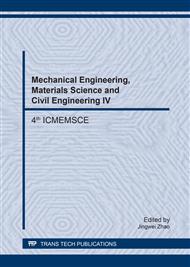[1]
Y. Liu, J.N. Cao, M.S. Geng, Technology for large rectangular ingot production with intensive water cooling, Iron and Steel. 49 (2014 )35-41.
Google Scholar
[2]
B. Blackwell, J. V. Beck, A technique for uncertainty analysis for inverse heat conduction problems, International Journal of Heat and Mass Transfer. 53 (2010)753-759.
DOI: 10.1016/j.ijheatmasstransfer.2009.10.014
Google Scholar
[3]
P. Duda, Numerical and experimental verification of two methods for solving an inverse heat conduction problem, International Journal of Heat and Mass Transfer. 84 (2015) 1101–1112.
DOI: 10.1016/j.ijheatmasstransfer.2015.01.082
Google Scholar
[4]
Kai Ho, D. Robert, Pehlke, Metal-Mold interfacial heat transfer, Metallurgical Transactions B. 16 (1985) 585-594.
DOI: 10.1007/bf02654857
Google Scholar
[5]
I. L. Ferreira, J. E. Spinelli, B. Nestler, et al, Influences of solute content, melt superheat and growth direction on the transient metal/mold interfacial heat transfer coefficient during solidification of Sn-Pb alloys, Materials Chemistry and Physics. 111 ( 2008) 444-454.
DOI: 10.1016/j.matchemphys.2008.04.044
Google Scholar
[6]
Z.P. Guo ,S.M. Xiong, Effects of alloy materials and process parameters on the heat transfer coefficient at metal/die interface in high pressure die casting, Acta Metallurgica Sinica. 44 (2008) 433-439.
Google Scholar
[7]
K. N. Prabhu, S. T. Kumar, N. Venkataraman, Heat transfer at the metal/substrate interface during solidification of Pb-Sn solder alloys, Journal of Materials Engineering and Performance. 11 (2002)265-273.
DOI: 10.1361/105994902770344051
Google Scholar
[8]
Z.P. Guo , S.M. Xiong, Study on heat transfer behavior at metal/die interface in aluminum alloy die casting process II, Acta Metallurgica Sinica. 43 (2007)1155-1160.
Google Scholar
[9]
T. S. P. Kumar , H. C. Kamath, Estimation of multiple heat-flux components at the metal/mold interface in bar and plate aluminum alloy castings, Metallurgical and Materials Transactions B. 35 (2004)575-585.
DOI: 10.1007/s11663-004-0056-y
Google Scholar
[10]
Z. Z. Sun, H. Hu , X. P. Niu, Determination of heat transfer coefficients by extrapolation and numerical inverse methods in squeeze casting of magnesium alloy AM60, Journal of Materials Processing Technology. 211 (2011)1432-1440.
DOI: 10.1016/j.jmatprotec.2011.03.014
Google Scholar
[11]
F. A. Ilkhchy, M. Jabbari and P. Davami, Effect of pressure on heat transfer coefficient at the metal/mold interface of A356 aluminum alloy, International Communications in Heat and Mass Transfer. 39 (2012)705-712.
DOI: 10.1016/j.icheatmasstransfer.2012.04.001
Google Scholar
[12]
A. Hamasaiid, M. S. Dargusch, C. J. Davidson, et al, Effect of mold coating materials and thickness on heat transfer in permanent mold casting of aluminum alloys, Metallurgical and Materials Transactions A. 38 (2007)1303-1316.
DOI: 10.1007/s11661-007-9145-2
Google Scholar
[13]
B. Coates, S. A. Argyropolulos, The effects of surface roughness and metal temperature on the heat-transfer coefficient at the metal mold interface, Metallurgical and Materials Transactions B. 38(2007)243-255.
DOI: 10.1007/s11663-007-9020-y
Google Scholar
[14]
P. Usha, R. K. V. Sreenivas, Numerical simulation of boundary heat flux transients and thermal field of the mould during gravity die-casting, Procedia Materials Science. 5(2014)2069-(2074).
DOI: 10.1016/j.mspro.2014.07.541
Google Scholar
[15]
J.V. Beck, B.F. Blackwell, J.C.R. St Clair, Inverse heat conduction Ill-posed problems, Wiley, New York, (1985).
Google Scholar


